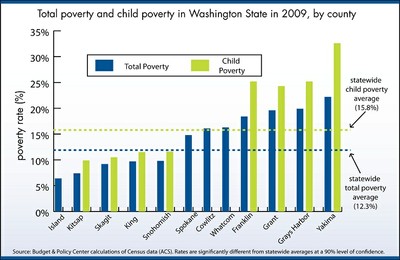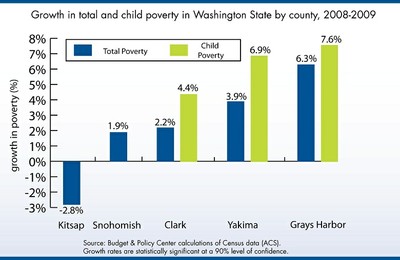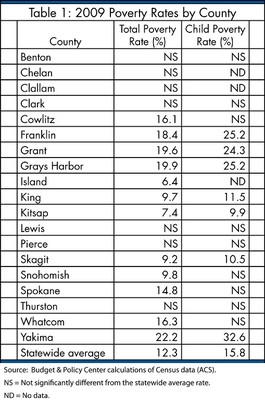Grays Harbor, Yakima, Clark, and Snohomish
Counties Saw Biggest Increases in Poverty
Posted by Andy Nicholas
at Oct 11, 2010 09:00 AM | Permalink
Though the
recession has been disastrous for families throughout Washington, Grays
Harbor, Yakima, Clark and Snohomish counties saw the fastest growth in
total poverty or child poverty from 2008 to 2009, according to an
analysis of new U.S. Census data by the Washington State Budget &
Policy Center.
The jump in people
living in poverty comes amid a recession that’s caused a dramatic
decline in state revenues. Especially in these counties, but in every
corner of the state as well, more people are living in poverty while
the services they need are being slashed.
In addition to
more than $4 billion in cuts passed the last two legislative sessions,
Gov. Gregoire recently called for 6 percent across-the-board budget
cuts – which drastically impact human services that support the
growing number of Washington families living in poverty.
According to the analysis:
Child poverty grew fastest in Grays
Harbor, Yakima, and Clark counties from 2008 to 2009. Grays Harbor
County experienced the fastest growth (7.6 percent) in child poverty of
any county in Washington (see graph below). Yakima County (6.3 percent)
and Clark County (4.4 percent) also saw child poverty grow
significantly.
Total poverty grew fastest in
Grays Harbor, Yakima, Clark, and Snohomish Counties from 2008 to 2009.
As with child poverty, Grays Harbor experienced the most rapid growth
(6.3 percent) in total poverty of any other county in Washington state
during this period.
The Poverty and jobless rates in Grays
Harbor County is still climbing in 2011.
NOTE: 2008/2009 was
about the time “Wild Olympics” Pew Environmental Group
started to conjure up their proposed plan to inflict on the residents
of the Olympic Peninsula. A“Kick-em while their down”
approach. “Vulturous
Predators” attacking our families by KILLING jobs.
Taking away our working land bases for wilderness enviro's to
gather in, is not the answer to the
health and welfare of our county or state. They already have a million
acres of park/wilderness now. They should go enjoy it instead of
worrying about hording more while others don't eat. Environmental
fanatics are, disregarding, assuming and taking generational
organizations. They have a job and money to vacation on. NO THANKS!
Total Poverty Rate in Washington State

Child Poverty in Washington State By
County

 As of August 2011 Grays
Harbor Hit #1 in Unemployment in the State.
As of August 2011 Grays
Harbor Hit #1 in Unemployment in the State.
Do we really need MORE of this? Like it or not we are getting it.
The sharp increases
mirror the increase in poverty statewide, and come amid major state
cuts. Cuts to services for vulnerable populations include maternity
support services for high-risk women, and mental health and medical
services for those with disabilities. Child welfare and support
services face a nearly $15 million cut, with reductions to foster care
agencies and support for those in home care.
More than $120 million in reductions to health care including reducing
coverage for more than 127,000 children, and cuts for adults which
include pharmacy benefit, prescription drugs, dental, vision, hearing,
podiatry and hospice coverage.
Senior citizens face cuts in
long term care, home care hours, and funds for boarding homes and other
locations that care for older adults.
While K-12 education was not
directly impacted, higher education will take a cut of $84 million to
universities, and community and technical colleges.
Prior to the 6.3 % across the board cuts, more than $51 million was cut
from TANF (Temporary Assistance to Needy Families) and related
programs, among those was a reduction in the eligibility level for
Working Connections Child Care, which will result in 2,500 families
that will be losing child care subsidies over the next nine months.For
the current budget year,o 2010
Two other special sessions were
required to close a projected $1.1 billion shortfall in FY2011 and in a
special session has made cuts in funding to K-12 schools, colleges and
universities, and social services.
Washington has total state debt of $30,455,510,003 when calculated by
adding the total of outstanding debt, pension and OPEB UAAL’s,
unemployment trust funds and the 2010 budget gap as of July 2010.
Fiscal Year 2012-13 State Budget
1. The state faces a budget shortfall of between $5.3 billion for the
coming biennial budget after a March 2011 revenue forecast knocked
another $780 million out of budget-writers’ hands.[8] The budget
is expected to be approximately $37 billion.[9] Tax collections for the
FY21012-13 two-year budget period are expected to be around $670
million lower than previously expected.
Legislative Budget
The Senate on April 18, 2011, approved its proposed two-year state
budget that reduces spending by $4.8 billion and cuts funding for K-12
education in an attempt to fill the $5.1 billion deficit. The Senate
plan reduced K-12 education funding by $250
million, which budget writers assume would come from a 3% wage cut for teachers. It also
cuts $95 million from school
districts based on class attendance. Gov. Gregoire said
she is concerned about the Senate cuts of $350 million to the state's
K-12 education system.
The House budget cuts higher
education by $482 million, more
than Gov. Gregoire's original proposal. It would cut state support for
higher education to the amount spent 20 years ago, when there were
32,000 fewer students at the six four-year colleges. The University of
Washington would lose $200 million
for the 2011-2013 biennium, a 30 percent cut.
Governor's Proposed Budget
Gov. Chris Gregoire proposed a state budget. The proposed budget is
based on a shortfall of nearly $5 billion. It would eliminate the
arts commission and the state
food-assistance program, reduce a host of other health and
social-service programs and cut funds for higher education. The
governor also said she intended to consolidate 21 state agencies down
to nine to save $22 million.
Education
The governor proposed spending
$13.8 billion on education over the next biennium, an increase over the
prior budget, most of which stems from the fact that the state is
expecting more students. Those funds are still about $1 billion short
of the level that would keep schools "treading water."
Gregoire's budget includes
a proposal of reducing or eliminating everything from
gifted education to bonuses for teachers who earn the prestigious
National Board Certification
"Should Park expansion be a priority during
the biggest economic breakdown in US history, that now topples the
"Great Depression" ?????
Unemployment is at a high with no solid jobs in sight. All jobs that are
talked about being created in the Harbor, are based on
projection. Few businesses planning to hire are doing just that
"planning on". All the spew about hoping to employ X amount of people.
Hoping???? Once again these are projections of visions not fact. We all
know where "projections", "planning on" and "hoping for" have led our
country. "Another day older and deeper in debt". These UNSTABLE
practices have crushed our nations present and future chance of
prospering and in some instances able to mearly exist.
Unemployment, depending on who is doing the study. It varies. The
Washinton State Employment Security Department under Grays Harbor County Profile
are some interesting figures on the jobs status. Last updated in
May 2011. We can assume the statistics have grown.
The Employment Security Dept. bases their studies on those currently
receiving benifits. You must keep in mind these statistics do not
include those who's benefits have run out. There are also those who
don't qualify (lack of required hours) or HS graduate students etc.
that have not yet entered the job market. To be accurrate all these
statistics have to be included in the percentage of those without jobs.
Depending on when these stats are recorded also make a difference.
During seasonal part time work, temporary Christmas employment etc.
will prove to hide stable findings in their study's. These are
important factors to consider which puts a much larger section of the
population under the gun. Shown statistics are at a much lower
level then an accurrate indepth study would prove.
Tightening harvests of renewable resources of any kind, that can
be replentished to produce over and over again, is killing the hands
that feed them. Does it make sense that a responsible congressman
or senator would even concider adding debt and destroying jobs? Should
this be
their top priority for the people of these Counties and State?
Especially
when infrastructures Nation wide are disintegrating? NO!
It is incompetency at it's best. What should be the responsile
decision of congress? JOBS, HEALTH and REBUILDING BROKEN
STABILITY!
Safety has also been an issue due to forced lay offs,
Austerity Hits Grays Harbor- http://www.pugetsoundanarchists.org/node/919
The sharp increases mirror
the increase in poverty statewide, and come amid major state cuts. Cuts
to services for vulnerable populations include maternity support
services for high-risk women, and mental health and medical services
for those with disabilities. Child welfare and support services face a
nearly $15 million cut, with reductions to foster care agencies and
support for those in home care.
More than $120 million in reductions
to health care including reducing coverage for more than 127,000
children, and cuts for adults which include pharmacy benefit,
prescription drugs, dental, vision, hearing, podiatry and hospice
coverage.
Senior citizens face cuts in long term
care, home care hours, and funds for boarding homes and other locations
that care for older adults.
While K-12 education was not directly
impacted, higher education will take a cut of $84 million to
universities, and community and technical colleges.
Prior to the 6.3 % across the board
cuts, more than $51 million was cut from TANF (Temporary Assistance to
Needy Families) and related programs, among those was a reduction in
the eligibility level for Working Connections Child Care, which will
result in 2,500 families that will be losing child care subsidies over
the next nine months.
2010 For the current
budget year, the
Two other special sessions were
required to close a projected $1.1 billion shortfall in FY2011 and in a
special session has made cuts in funding to K-12 schools, colleges and
universities, and social services.
Washington has total state debt of
$30,455,510,003 when calculated by adding the total of outstanding
debt, pension and OPEB UAAL’s, unemployment trust funds and the
2010 budget gap as of July 2010.
Fiscal Year 2012-13 State Budget
1. The state faces a budget shortfall
of between $5.3 billion for the coming biennial budget after a March
2011 revenue forecast knocked another $780 million out of
budget-writers’ hands.[8] The budget is expected to be
approximately $37 billion.[9] Tax collections for the FY21012-13
two-year budget period are expected to be around $670 million lower
than previously expected.[10]
Legislative Budget
The Senate on April 18, 2011, approved
its proposed two-year state budget that reduces spending by $4.8
billion and cuts funding for K-12 education in an attempt to fill the
$5.1 billion deficit. The Senate plan reduced K-12 education funding by
$250 million, which budget writers assume would come from a 3% wage cut
for teachers. It also cuts $95 million from school districts based on
class attendance. Gov. Gregoire said she is concerned about the
Senate cuts of $350 million to the state's K-12 education system.
The House budget cuts higher education
by $482 million, more than Gov. Gregoire's original proposal. It would
cut state support for higher education to the amount spent 20 years
ago, when there were 32,000 fewer students at the six four-year
colleges. The University of Washington would lose $200 million for the
2011-2013 biennium, a 30 percent cut.
Governor's Proposed Budget
Gov. Chris Gregoire proposed a state
budget. The proposed budget is based on a shortfall of nearly $5
billion. It would would eliminate the arts commission and the state
food-assistance program, reduce a host of other health and
social-service programs and cut funds for higher education. The
governor also said she intended to consolidate 21 state agencies down
to nine to save $22 million.
Education
The governor proposed spending $13.8
billion on education over the next biennium, an increase over the prior
budget, most of which stems from the fact that the state is expecting
more students. Those funds are still about $1 billion short of the
level that would keep schools "treading water."
Gregoire's budget includes a
proposal of reducing or eliminating everything from gifted
education to bonuses for teachers who earn the prestigious National
Board Certification.
Since this
article was written another 4% cut is being put into motion.




